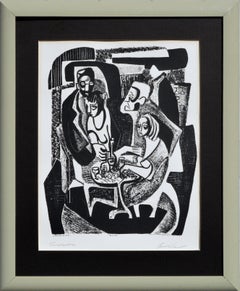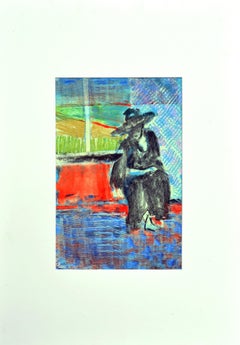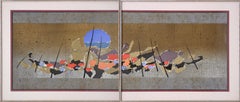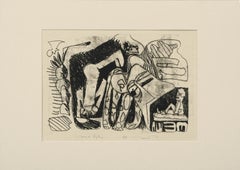Want more images or videos?
Request additional images or videos from the seller
1 of 10
Amram EbgiChildren with Balloons in Safat
Price:$300
$489List Price
About the Item
- Creator:Amram Ebgi (1939, American, Israeli)
- Dimensions:Height: 20.25 in (51.44 cm)Width: 18.25 in (46.36 cm)Depth: 0.75 in (1.91 cm)
- Medium:
- Movement & Style:
- Period:
- Condition:Minor foxing.
- Gallery Location:Soquel, CA
- Reference Number:Seller: j50251stDibs: LU5422830903
About the Seller
5.0
Platinum Seller
Premium sellers with a 4.7+ rating and 24-hour response times
Established in 1986
1stDibs seller since 2014
3,010 sales on 1stDibs
Authenticity Guarantee
In the unlikely event there’s an issue with an item’s authenticity, contact us within 1 year for a full refund. DetailsMoney-Back Guarantee
If your item is not as described, is damaged in transit, or does not arrive, contact us within 7 days for a full refund. Details24-Hour Cancellation
You have a 24-hour grace period in which to reconsider your purchase, with no questions asked.Vetted Professional Sellers
Our world-class sellers must adhere to strict standards for service and quality, maintaining the integrity of our listings.Price-Match Guarantee
If you find that a seller listed the same item for a lower price elsewhere, we’ll match it.Trusted Global Delivery
Our best-in-class carrier network provides specialized shipping options worldwide, including custom delivery.You May Also Like
Ghosts of Philadelphia 2
By Tom Bennett
Located in Brooklyn, NY
Monotype
Dramatic imagery from Tom Bennett’s series of black and white monotypes, blending surrealistic mindscapes with stark realism
About Tom Bennett:
With quick brushstrokes, Tom...
Category
2010s Expressionist Figurative Prints
Materials
Monotype, Archival Ink
The Mother / - Violated Motherhood -
By Georg Tappert
Located in Berlin, DE
Georg Tappert (1880 Berlin - 1957 Berlin), The Mother, 1918 (1964). Estate print from 1964. Linocut on Japan, 31.5 cm x 20 cm (image), 44.5 cm x 28 cm (sheet size), marked lower left...
Category
1910s Expressionist Figurative Prints
Materials
Paper
Adoration of the Magi / - The Rider of the Sun -
Located in Berlin, DE
Walter Helbig (1878 Falkenstein - 1968 Ascona), Adoration of the Magi, 1918. Hand-colored linocut, 30 cm x 22.5 cm (depiction), 50 cm x 35 cm (sheet size), signed “W.[alter] Helbig” in pencil lower right, inscribed “Adoration of the Magi” lower left and dated “1918”. Below this a handwritten dedication “with heartfelt Christmas greetings”.
- Paper somewhat darkened and with slight creases, thumbtack holes in the corners
- The Rider of the Sun -
The 'apocalypse' of World War I brought about a return to sacred art. Walter Helbig belonged to the circle of the 'Brücke' and the 'Blauer Reiter'. With his reinterpretation of religious themes in an expressionist formal language, Helbig shaped an avant-garde neo-sacred art. This is symbolically expressed in the silhouette of the rider against the sun-like yellow background. It refers to the awakening initiated by the Blue Riding, which is now linked back to the sacred.
The rider and horse "look" at Mary and the Christ Child, who occupy the entire field. Opposite them are the three kings, the eldest of whom kneels before Christ and offers him a gold-filled casket. The expressionist lines give rise to a tower that rises into the "sun", so that the gift has become a Gothic church, expressing the hope that the fallen world will be resurrected in the name of Christ. This dimension of meaning is emphasized by the magical effect of the color scheme.
About the artist
In 1895, Walter Helbig began studying at the Dresden Academy of Art, where he became friends with the future Brücke artist Otto Müller, with whom he lived in Dresden from 1903 to 1905. While studying in Italy from 1897 to 1899, he met Arnold Böcklin and Adolf von Hildebrand. After completing his studies, he first worked for Otto Gussmann, painting churches. From 1905 to 1909 he worked as a freelance painter in Hamburg. In 1909, through the mediation of Otto Müller, Helbig made the acquaintance of artists from the 'Brücke'. In 1910 he exhibited at the founding exhibition of the Berlin 'Neue Sezession'. In the same year, he moved to Switzerland, where, together with Hans Arp and Oscar Lüthy, he founded the 'Moderne Bund' in Weggis, to which Cuno Amiet and Giovanni Giacometti also belonged. At the second exhibition of the 'Moderne Bund' in Zurich in 1911, Henri Matisse and Robert Delaunay were represented alongside artists from the 'Blauer Reiter'. In 1913, Helbig traveled to Paris with Arp and Lüthy. After the dissolution of the 'Moderne Bund', Helbig was represented at the first Dada exhibition in Zurich in 1914. In 1919, he joined the Berlin 'Novembergruppe'. After the devastation of World War I, Helbig turned increasingly to religious themes in his work. In 1924, like many other artists of his time, he moved to Ascona for financial reasons, where he became a naturalized citizen in 1938. There he founded the artists' association "The Great Bear", to which Marianne von Werefkin...
Category
1910s Expressionist Figurative Prints
Materials
Paper
$777
H 19.69 in W 13.78 in D 0.4 in
Polish French Figurative Abstract Art Brut Expressionist Lithograph Maryan
By Pinchas Maryan
Located in Surfside, FL
Pinchas Burstein, known as Maryan
Lithograph (after the drawing).
1960
Dimensions: 12 3/8 x 9 3/8 inches (315 x 240mm).
There is printed text on the back, as issued.
Signed in the...
Category
1960s Expressionist Figurative Prints
Materials
Paper, Lithograph
Polish French Figurative Abstract Art Brut Expressionist Lithograph Maryan
By Pinchas Maryan
Located in Surfside, FL
Pinchas Burstein, known as Maryan
Lithograph (after the drawing).
1960
Dimensions: 12 3/8 x 9 3/8 inches (315 x 240mm).
There is printed text on the back, as issued.
Signed in the...
Category
1960s Expressionist Figurative Prints
Materials
Paper, Lithograph
Polish French Figurative Abstract Art Brut Expressionist Lithograph Maryan
By Pinchas Maryan
Located in Surfside, FL
Pinchas Burstein, known as Maryan
Lithograph (after the drawing).
1960
Dimensions: 12 3/8 x 9 3/8 inches (315 x 240mm).
Gold or bronze ink on black paper
Signed in the plate, not b...
Category
1960s Expressionist Figurative Prints
Materials
Paper, Lithograph
Alberto Giacometti, rare vintage original poster
By Alberto Giacometti
Located in Saint Ouen, FR
Rare vintage original poster published by the famous Paris Gallery Claude Bernard pour an historic exhibition of Jean Dubuffet in the sixties (1964) a...
Category
1960s Expressionist Abstract Prints
Materials
Paper
$418
H 25.6 in W 16.93 in D 0.4 in
Je sens monter en moi des chants de plaisir (I Feel Songs of Pleasure Rise in Me
By Théo Tobiasse
Located in San Francisco, CA
Artist: Theo Tobiasse (French/Israeli, 1927-2012)
Title: Je Sens monter en moi des chants de plaisir (I Feel Songs of Pleasure Rise in Me)
Year: Circa 1980
Medium: Color lithograp...
Category
1980s Expressionist Figurative Prints
Materials
Paper, Lithograph
$1,250
H 22.25 in W 30 in D 0.1 in
CARABINIERI A OSTIA
By Nicola Simbari
Located in Aventura, FL
Serigraph on paper. Hand signed and numbered by the artist. Artwork size 27.5 x 19.5 inches. Frame size approx 32 x 24 inches. Artwork is in excellent condition. Edition of 125. C...
Category
1990s Expressionist Abstract Prints
Materials
Paper, Screen
Demonio II
By Jose Clemente Orozco
Located in New York, NY
A superb, richly-inked impression of this very scarce aquatint. Edition of approximately 80. Signed in pencil by Orozco.
Category
1940s Expressionist Abstract Prints
Materials
Aquatint
More From This Seller
View AllNick's Coffee House in the Village - Rare Edition 1970s Modern Figurative Print
By Lenore SImon
Located in Soquel, CA
This bold screen print depicts a scene from the 1950s, set in a jazz coffee house in Greenwich Village called Nick's, which Simon patronized while in high school. The original stone ...
Category
Late 20th Century Expressionist Figurative Prints
Materials
Archival Paper, Screen
Figurative Abstract -- Man at the Well
Located in Soquel, CA
Figurative abstract with a colorful textured background and figure in black by an unknown artist (American, 20th Century). Hand pulled lithograph with hand work augmentation. Unsign...
Category
1980s Modern Figurative Prints
Materials
Paper, Ink
$540 Sale Price
20% Off
Japanese Fishing Boats, Abstract Diptych Screen Print
Located in Soquel, CA
Abstract Screen print (Serigraph) composition of Japanese fishing boats in two parts by an unknown artist (20th Century). Signed (possibly "Myketo") a...
Category
Late 20th Century Abstract Abstract Prints
Materials
Paper, Ink, Screen
$2,000 Sale Price
20% Off
Abstract Lithograph with Animals and Figures
By Michael William Eggleston
Located in Soquel, CA
Abstract figurative lithograph with a lively jumble of abstracted animal and figurative forms by Michael William Eggleston (American, 20th Century). Titled (illegible), numbered ("5/...
Category
Late 20th Century Abstract Expressionist Abstract Prints
Materials
Paper, Ink, Lithograph
$700 Sale Price
20% Off
Two Faces, Modern Self-Portrait Lithograph of the Artist Aging in Pink & Green
By Dennis John Ashbaugh
Located in Soquel, CA
Limited edition hand signed lithograph featuring two consecutive modern portraits of faces with varying degrees of abstraction, in pink and green, by Dennis john Ashbaugh (American, b. 1946). Numbered "7/7" in the lower-left corner. Signed "Dennis John Ashbaugh" in the lower right corner. Presented in a new tan mat with foam core backing. Unframe. Image size: 4"H x 6.75"W. Some toning yellowing at mat opening.
Dennis John Ashbaugh (American, b. 1946) was born in Red Oak, Iowa, and attended California State University at Fullerton, receiving his MA in 1969. Ashbaugh has spent most of his career in New York City.
In 1992, he collaborated with William Gibson, a fiction writer, and with publisher Kevin Begos on a book, Agrippa, meaning 'book of the dead'. Exhibition venues include the Metropolitan Museum of Art in New York City, the P.S.1 Contemporary Art Center, the Seattle Art Museum, and the Whitney Museum of American ArtPublic collections holding his work include the Hirshhorn Museum, the Museum of Fine Arts, Houston, the Los Angeles County Museum of Art, and the New York Metropolitan. He received a Guggenheim Fellowship.
Ashbaugh lives in a trim frame house in Flamingo Park...
Category
1970s Modern Figurative Prints
Materials
Paper, Ink, Lithograph
Kandinsky at Galerie Karl Flinker - 1977 Exhibition Poster - in Ink on Paper
By Wassily Kandinsky
Located in Soquel, CA
Kandinsky at Galerie Karl Flinker - 1977 Exhibition Poster - in Ink on Paper
Poster with a reproduction of "Merry Structure" by Vassily Kandinsky (Russian, 1866-1944). This posted i...
Category
1970s Abstract Geometric Abstract Prints
Materials
Paper, Ink, Lithograph
Recently Viewed
View AllMore Ways To Browse
Lucien Krief
Salvador Dali Litho
Salvador Dali Lobster
Salvador Dali Mao
Salvador Dali Melting Clock
Salvador Dali Pig
Salvador Dali Shakespeare
Salvador Dali Woman With A Whip
Sascha Schneider
Sean Caulfield
Sebastien Leclerc
Shabbat Shalom
Shag Agle
Shalom Moskowitz Shalom Of Safed
Shepard Fairey Oil
Spoleto Poster
Stag Salvador Dali
Suffering Moses



